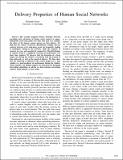| dc.contributor.author | Sollins, Karen R. | |
| dc.contributor.author | Sastry, Nishanth | |
| dc.contributor.author | Crowcroft, Jon | |
| dc.date.accessioned | 2010-10-04T14:58:19Z | |
| dc.date.available | 2010-10-04T14:58:19Z | |
| dc.date.issued | 2009-06 | |
| dc.date.submitted | 2009-04 | |
| dc.identifier.isbn | 978-1-4244-3513-5 | |
| dc.identifier.issn | 0743-166X | |
| dc.identifier.other | INSPEC Accession Number: 10685686 | |
| dc.identifier.uri | http://hdl.handle.net/1721.1/58850 | |
| dc.description.abstract | The recently proposed packet switched network paradigm takes advantage of human social contacts to opportunistically create data paths over time. Our goal is to examine the effect of the human contact process on data delivery. We find that the contact occurrence distribution is highly uneven: contacts between a few node-pairs occur too frequently, leading to inadequate mixing in the network, while the majority of contacts are rare, and essential for connectivity. This distribution of contacts leads to a significant variation in performance over short time windows. We discover that the formation of a large clique core during the window is correlated with the fraction of data delivered, as well as the speed of delivery. We then show that the clustering co-efficient of the contact graph over a time window is a good predictor of performance during the window. Taken together, our findings suggest new directions for designing forwarding algorithms in ad-hoc or delay-tolerant networking schemes using humans as data mules. | en_US |
| dc.language.iso | en_US | |
| dc.publisher | Institute of Electrical and Electronics Engineers | en_US |
| dc.relation.isversionof | http://dx.doi.org/10.1109/INFCOM.2009.5062192 | en_US |
| dc.rights | Article is made available in accordance with the publisher's policy and may be subject to US copyright law. Please refer to the publisher's site for terms of use. | en_US |
| dc.source | IEEE | en_US |
| dc.title | Delivery properties of human social networks | en_US |
| dc.type | Article | en_US |
| dc.identifier.citation | Sastry, Nishanth, Sollins, Karen, and Crowcroft, Jon (2009). Delivery properties of human social networks. IEEE INFOCOM 2009 proceedings (Piscataway, N.J.: IEEE): 2586-2590. © 2009 IEEE | en_US |
| dc.contributor.department | Massachusetts Institute of Technology. Computer Science and Artificial Intelligence Laboratory | en_US |
| dc.contributor.approver | Sollins, Karen R. | |
| dc.contributor.mitauthor | Sollins, Karen R. | |
| dc.relation.journal | IEEE INFOCOM 2009 proceedings | en_US |
| dc.eprint.version | Final published version | en_US |
| dc.type.uri | http://purl.org/eprint/type/JournalArticle | en_US |
| eprint.status | http://purl.org/eprint/status/PeerReviewed | en_US |
| dspace.orderedauthors | Sastry, N.; Sollins, K.; Crowcroft, J. | en |
| mit.license | PUBLISHER_POLICY | en_US |
| mit.metadata.status | Complete | |
